Cross stitch, Needlecraft and Embroidery Glossary: Vandyke stitch to Vertical cross stitch
A comprehensive illustrated needlecraft dictionary with clear definitions and working diagrams. Includes 766 terms used in cross stitch, embroidery, tapestry, blackwork, and goldwork. (Click thumbnails to enlarge.)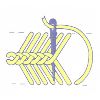
An even tension is important to prevent the central plait becoming untidy. This makes a good band in a border or it can be used as a ridged filling stitch. Work from top to bottom. Start at left edge below top of stitch line. Take thread up to top of stitch line at centre and take a tiny stitch from left to right at centre. Then make a long stitch to right edge level with starting point, insert needle and carry thread across back bringing it out again on left edge just below starting point. Without needle entering fabric, take thread behind crossed threads in centre from right to left then insert needle on right edge just below previous point. Continue working in this way.

A central straight stitch is worked over eight fabric threads with an oblong cross stitch of the same height on top. The stitch is completed by a shorter wider oblong cross stitch as shown. These stitches fill an area by interlocking as in the diagram and any gaps showing can be filled with tent stitch.
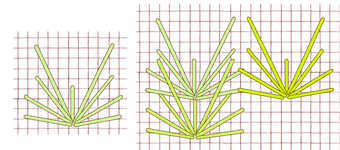
Work from top to bottom and left to right with the stitches overlapping. The first stitch is worked upright over four threads with four slanting stitches on either side sharing the same hole. The second block is worked directly below the first with the top of the base stitch sharing the same central hole and the radiating stitches overlapping the previous block.
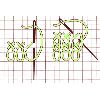
Work a stitch diagonally across two intersections, make a second stitch in the same place but leave a loop of thread. A knitting needle can be used to gauge the length of the loop. Then complete the cross and bring needle out again down and to the right across two intersections ready to start the next stitch. After all the rows are complete, cut loops and trim evenly.
Also known as astrakhan stitch, rug stitch, tassel stitch, raised stitch and plush stitch.
It can also be worked using two different threads, one for the crosses and one for the loops as illustrated.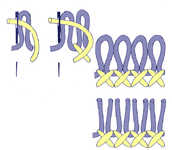 .
.
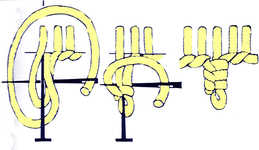
This is worked at intervals along a buttonhole edging as illustrated.
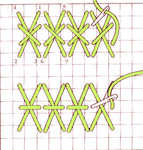
The base cross is worked like cross stitch but over two threads wide and four threads high. The stitch can then either be completed with a basic cross stitch or a backstitch over two threads at the centre. The second set of stitching can be worked in a contrasting colour when it would be better to use two needles. The two version can be mixed perhaps by working in alternate rows.






